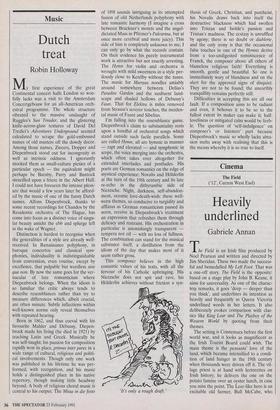Music
Dutch treat
Robin Holloway
My first experience of the great Continental concert halls London so woe- fully lacks was a visit to the Amsterdam Concertgebouw for an all-American orch- estral programme. The whole structure vibrated to the massive onslaught of Ruggles's Sun Treader, and the glistering knife-across-glass textures of David Del Tredici's Adventures Undetground seemed calculated to scrape the gold-embossed names of old masters off the dowdy decor. Among those names, Zweers, Dopper and Diepenbrock stood out for incongruity as well as intrinsic oddness. I ignorantly mocked them as small-culture pieties of a particular epoch — the equivalent might perhaps be Barnby, Parry and Bantock stencilled upon a frieze in the Albert Hall. I could not have foreseen the intense pleas- ure that would a few years later be afford- ed by the music of one of the funny Dutch names. Alfons Diepenbrock, thanks to some recent recordings for Chandos by the Residentie orchestra of The Hague, has come into focus as a distinct voice of singu- lar beauty amidst the ebb and splurge left in the wake of Wagner.
Distinction is hardest to recognise when the generalities of a style are already well- received. In Renaissance polyphony, in baroque concertos and classical sym- phonies, individuality is indistinguishable from convention, even routine, except by excellence, that palpable but wordless sine qua non. By now the same goes for the ver- nacular of late romanticism where Diepenbrock belongs. When the idiom is so familiar the critic always tends to describe resemblances rather than try to measure differences which, albeit crucial, are often minute. Subtle inflections within well-known norms only reveal themselves with repeated hearing.
Born in 1862, and thus coeval with his favourite Mahler and Debussy, Diepen- brock made his living (he died in 1921) by teaching Latin and Greek. Musically he was self-taught; his passion for composition rapidly won its place, primus inter pares in a wide range of cultural, religious and politi- cal involvements. Though only one work was published in his lifetime he was per- formed, with recognition, and his music holds a distinguished place in his native repertory, though making little headway beyond. A body of religious choral music is central to his output. The Missa in die festo of 1891 sounds intriguing in its attempted fusion of old Netherlands polyphony with late romantic harmony (I imagine a cross between Bruckner's motets and the angel- dictated Mass in Pfitzner's Palestrina, but at once more cerebral and more juicy). This side of him is completely unknown to me; I can only go by what the records contain. On their evidence his purely instrumental work is attractive but not exactly arresting. The Hymn for violin and orchestra is wrought with mild sweetness in a style per- ilously close to Ketelby without the tunes. The music for Marsyas noodles amiably around somewhere between Delius's Paradise Garden and the sunburnt land- scape and shaded hollows of Debussy's Faun. That for Elektra is miles removed from Strauss's severer touches, the inciden- tal music of Faure and Sibelius.
I'm falling into the resemblance game. Diepenbrock's claim to substantiality rests upon a handful of orchestral songs which stand outside such facile parallels. Some are called Hymn, all are hymnic in manner — rapt and elevated — and symphonic in scope, the voice merging into the orchestra, which often takes over altogether for extended interludes and postludes. His poets are German romantics on the edge of mystical experience: Novalis and Holderlin at the turn of the 19th century and its late re-echo in the dithyrambic side of Nietzsche. Night, darkness, self-abandon- ment, oceanic love-death-wish: these well- worn themes, so conducive to turgidity and afflatus as German romanticism passed its noon, receive in Diepenbrock's treatment an expression that refreshes them through delicacy and restraint. His orchestration in particular is astonishingly transparent — tempera not oil — with no loss of fullness. The combination can stand for the musical substance itself, a distillation from the idiom of the day that makes most of it seem rather gross.
This composer believes in the high romantic values of his texts, with all the fervour of his Catholic upbringing. His Nietzsche does not spit and rave, his Helderlin achieves without friction a syn- 'It's only a rough draft.' thesis of Greek, Christian, and pantheist, his Novalis draws back into itself the destructive blackness which had swollen into Tristan and Isolde's passion and Tristan's madness. The ecstasy is unruffled by agony; there is no doubt or diablerie, and the only irony is that the occasional false touches in one of the Hymns derive from a too-undigested reminiscence of Franck, the composer above all others of blameless religious faith! Everything is smooth, gentle and beautiful. So one is immediately wary of blandness and on the alert for the approved signs of disquiet. They are not to be found; the unearthly tranquillity remains perfectly still.
Difficulties in accepting this are all our fault. If a composition aims to be radiant and even, it behoves it to be so to the fullest extent its maker can make it; half- loveliness or mitigated calm would be feeb- le. The question of 'self-indulgence' on composer's or listeners' part because Diepenbrock's music so wholly lacks abra- sion melts away with realising that this is the means whereby it is so true to itself.


















































 Previous page
Previous page